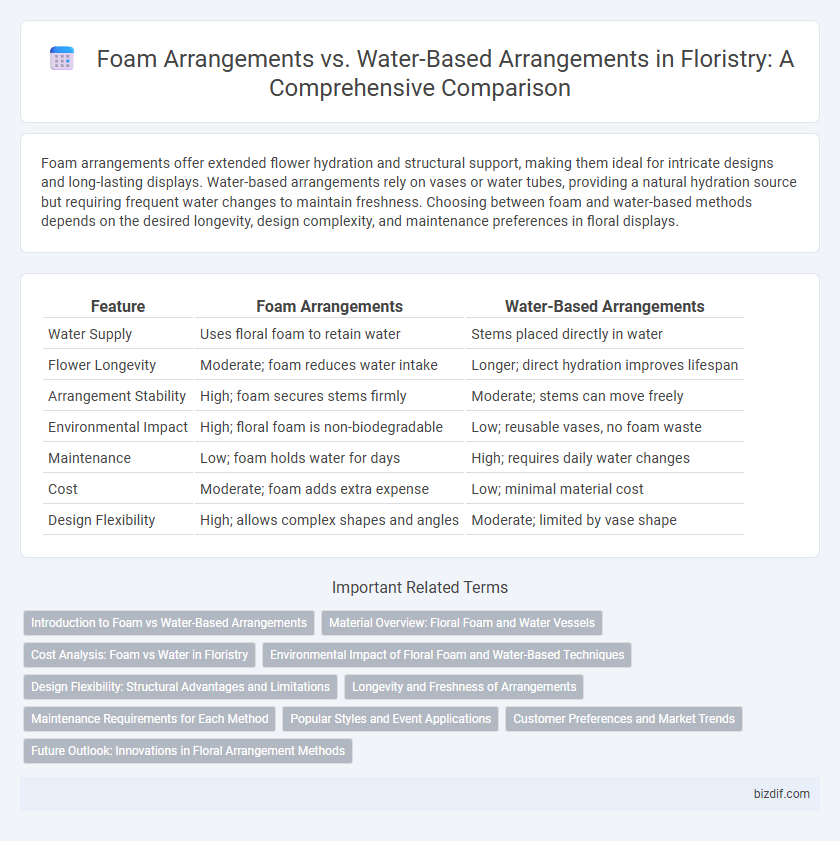Foam arrangements offer extended flower hydration and structural support, making them ideal for intricate designs and long-lasting displays. Water-based arrangements rely on vases or water tubes, providing a natural hydration source but requiring frequent water changes to maintain freshness. Choosing between foam and water-based methods depends on the desired longevity, design complexity, and maintenance preferences in floral displays.
Table of Comparison
| Feature | Foam Arrangements | Water-Based Arrangements |
|---|---|---|
| Water Supply | Uses floral foam to retain water | Stems placed directly in water |
| Flower Longevity | Moderate; foam reduces water intake | Longer; direct hydration improves lifespan |
| Arrangement Stability | High; foam secures stems firmly | Moderate; stems can move freely |
| Environmental Impact | High; floral foam is non-biodegradable | Low; reusable vases, no foam waste |
| Maintenance | Low; foam holds water for days | High; requires daily water changes |
| Cost | Moderate; foam adds extra expense | Low; minimal material cost |
| Design Flexibility | High; allows complex shapes and angles | Moderate; limited by vase shape |
Introduction to Foam vs Water-Based Arrangements
Floral foam arrangements use a dense, sponge-like material that securely holds stems and retains water, ensuring prolonged freshness and precise placement. Water-based arrangements rely on containers filled with water, allowing flowers to absorb hydration naturally while offering flexibility in design and easy maintenance. Understanding the benefits of foam for structured displays versus the organic flow of water-based designs helps florists choose the ideal method for each floral project.
Material Overview: Floral Foam and Water Vessels
Floral foam provides sturdy support and water retention for fresh flowers, enabling complex, long-lasting arrangements by holding stems in place and supplying hydration. Water vessels, such as vases or bowls, offer a natural hydration method while requiring careful stem placement for stability and typically enhancing the arrangement's aesthetic appeal. Choosing between floral foam and water vessels depends on the desired design complexity, longevity, and environmental considerations, as foam is less eco-friendly compared to reusable water containers.
Cost Analysis: Foam vs Water in Floristry
Foam arrangements typically incur higher initial costs due to specialized purchase and disposal fees, while water-based arrangements rely on less expensive vases and fresh water refills that require frequent maintenance. Foam offers extended vase life and stability, potentially reducing long-term replacement expenses, whereas water-based arrangements may demand more frequent flower replacements and water changes, impacting ongoing costs. Evaluating florist supply budgets, labor time, and environmental disposal fees is essential for determining the most cost-effective approach between foam and water floral arrangements.
Environmental Impact of Floral Foam and Water-Based Techniques
Floral foam, commonly used in foam arrangements, poses significant environmental concerns due to its non-biodegradable composition and release of toxic chemicals during disposal. Water-based techniques, such as using floral tubes or mechanics, offer eco-friendly alternatives by reducing plastic waste and supporting sustainable floral practices. Choosing water-based methods minimizes pollution and promotes biodegradability, aligning with environmentally conscious floristry standards.
Design Flexibility: Structural Advantages and Limitations
Foam arrangements offer superior design flexibility by securely anchoring stems in any desired position, enabling complex and stable structures that water-based arrangements cannot easily achieve. Water-based designs rely on vase or container support, which limits the ability to create intricate shapes or suspend elements within the arrangement. The structural advantage of floral foam provides enhanced control over stem placement, but it may pose environmental concerns compared to the more natural hydration method of water-based arrangements.
Longevity and Freshness of Arrangements
Foam arrangements provide superior hydration by continuously supplying water to stems, extending flower longevity compared to traditional water-based arrangements that rely on regular water changes. The foam's ability to retain moisture ensures flowers remain fresh for a longer period, reducing wilting and dehydration. In contrast, water-based arrangements require frequent maintenance to prevent bacteria buildup and preserve freshness, making foam an efficient choice for long-lasting displays.
Maintenance Requirements for Each Method
Foam arrangements require regular misting and careful monitoring to prevent the drying out of the floral foam, which is essential to maintain flower freshness and structural integrity. Water-based arrangements demand consistent water level checks and changes every two days to avoid bacterial growth that can shorten flower lifespan. Both methods benefit from removing wilted blooms promptly to sustain overall arrangement health and prolong visual appeal.
Popular Styles and Event Applications
Foam arrangements offer versatile sculpting options suitable for intricate designs like bridal bouquets and memorial displays, maintaining floral freshness without water access. Water-based arrangements are popular in events requiring longevity, such as weddings and corporate functions, providing optimal hydration for extended bloom life. Both styles cater to specific event themes and duration, with foam favored for complex structures and water-based for natural presentation and prolonged freshness.
Customer Preferences and Market Trends
Customers increasingly prefer water-based floral arrangements due to their environmental sustainability and longer flower freshness, driving a market trend toward eco-friendly options. Foam arrangements remain popular for complex, structural designs but face declining demand as awareness of foam disposal issues grows. Market analysis indicates a steady shift favoring water-based solutions, reflecting consumer priorities on health, biodegradability, and natural aesthetics in floristry.
Future Outlook: Innovations in Floral Arrangement Methods
Advancements in floral foam alternatives prioritize sustainability and biodegradability, steering the industry away from traditional plastic-based foam. Water-based arrangements are evolving with smart hydration systems that prolong flower freshness and reduce water waste. Emerging technologies integrate sensors and automated irrigation to optimize floral longevity, signaling a shift towards eco-friendly and efficient floral design methods.
Foam arrangements vs water-based arrangements Infographic

 bizdif.com
bizdif.com